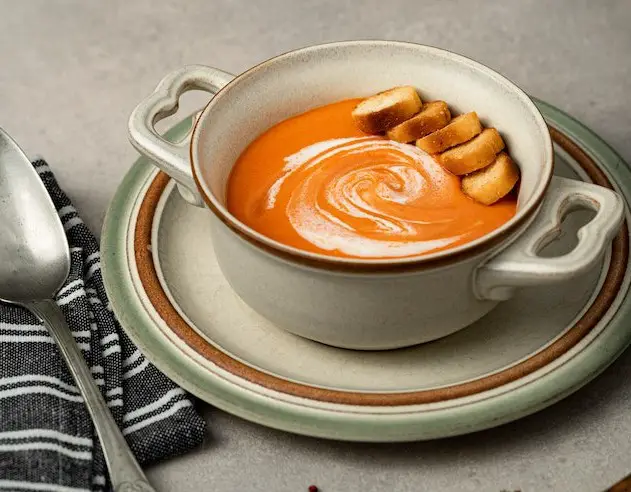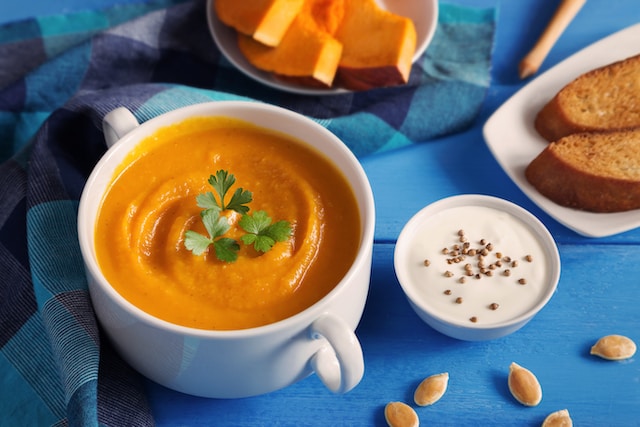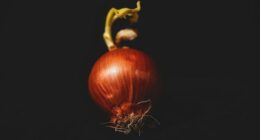Puree is a smooth and creamy blend that works well as a base for soups or sauces, whereas paste is thicker with concentrated flavors that work well for adding depth to dishes like curries or stews.
What is puree?
(Photo by Monica Turlui)

Puree is a smooth and creamy mixture made by blending cooked or raw ingredients until they become soft and uniform. This technique is often used to create sauces, soups, dips, baby food, and more.
Purees can be made from a variety of fruits, vegetables, legumes, grains, meats or fish. You can make puree out of anything that you want to turn into a smooth consistency.
One benefit of using purees in recipes is that they add flavor and texture without the need for added fats or oils. Additionally, pureed foods are easy to digest which makes them ideal for individuals with digestive problems.
To make your own puree at home simply start by cooking your desired ingredient(s) until it’s tender enough to blend easily. Then place the cooked ingredient(s) into a blender or food processor along with any seasonings you desire such as salt or pepper. Blend until everything becomes smooth like silk.
Puree is essentially just a fancy term for blended food! It’s an excellent way to incorporate healthy foods into your diet while adding flavor and nutrition-rich goodness to recipes effortlessly!
What is paste?
(Photo By Marco Verch on Flickr)

Paste is a thick and concentrated mixture that is made by grinding or crushing ingredients until they become smooth. It’s commonly used in cooking as a base for sauces, marinades, soups, and stews. Unlike puree, paste has a thicker consistency which makes it ideal for recipes that require intense flavor.
There are various types of paste available in the market such as tomato paste, chili paste, garlic paste, ginger paste and many more. Each type of paste has its unique taste profile which can add depth to any dish.
Tomato paste is one of the most popular types of pastes used around the world. It’s made by cooking ripe tomatoes until they break down into a thick sauce-like texture. Tomato Paste has an umami-rich flavor that adds complexity to pasta dishes like spaghetti bolognese or pizza sauce.
Chili pastes are another great example; they’re typically made from combining different varieties of hot peppers with vinegar and other spices creating a spicy condiment perfect for dipping sauces or adding heat to stir-fries.
Paste offers versatility in both sweet and savory dishes making it an essential ingredient found throughout kitchens worldwide!
Puree Vs. Paste – Key differences
Puree is a smooth mixture of vegetables or fruits that have been cooked, blended or sieved until they reach a thick consistency with no visible chunks. Purees can be made from various ingredients such as potatoes, carrots, peas, apples and more. They are commonly used in soups and sauces.
Paste on the other hand is thicker than puree and has less water content. It’s usually made by grinding ingredients into a fine pulp without adding any liquid to it. Common pastes include tomato paste which is used for pizza sauce; curry paste which adds flavor to curries; garlic paste for marinades or dressings among others.
The texture difference between these two also affects how they’re used in recipes – puree tends to be added in larger quantities while paste requires smaller amounts but packs quite an intense flavor punch!
In terms of storage life, pastes tend to last longer due to their reduced moisture content compared to purees which can spoil faster if not refrigerated promptly after preparation.
Both puree and paste serve different purposes when preparing dishes in the kitchen with each one providing its unique properties depending on what you want your dish to taste like!
How to make a puree
Puree is a versatile ingredient that can be used in various recipes, from soups to desserts. Making puree at home is easy and requires only a few simple steps. Here’s how you can make puree at home:
- Choose your ingredients – Purees can be made with fruits or vegetables depending on the recipe you’re making.
- Wash and prep your ingredients – Rinse your fruits or vegetables under cold water to remove any dirt or debris. Cut them into small pieces for easier blending.
- Blend the ingredients – Place the cut pieces of fruit or vegetable in a blender, food processor, or immersion blender and blend until smooth.
- Strain (optional) – To achieve an even smoother texture strain through a fine mesh strainer.
- Store/Use- You can store homemade purees in an air-tight container in the fridge for up to 3 days, but it’s recommended to use as soon as possible when fresh.
Making puree at home is quick, easy and cost-effective compared to buying pre-made ones at grocery stores which often contain added preservatives and sugars..
How to make a paste
When it comes to making a paste, the process is quite different from pureeing. A paste is typically thicker than a puree and has a more concentrated flavor profile. Here’s how you can make your own paste at home:
- Choose your base ingredient: The most common ingredients used for making pastes are garlic, ginger, and chili peppers. Other popular options include tomato, onion, and herbs.
- Prep your ingredients: Peel and chop your chosen ingredient into small pieces that will be easier to blend together.
- Blend the ingredients together: Add all of your chopped ingredients into a blender or food processor with some oil or water to help create a smooth texture.
- Adjust consistency as needed: If the mixture seems too thick for your liking, add more liquid until it reaches the desired consistency.
- Store in an airtight container: Transfer the paste to an airtight jar or container and store it in the fridge for up to 2 weeks.
Making your own homemade paste can be a fun way to experiment with new flavors in cooking while also saving money on store-bought varieties!
Recipes that use puree and paste
Purees and pastes are versatile ingredients that can be used in a variety of recipes. Puree is perfect for making soups, sauces, and smoothies while paste is ideal for adding flavor to curries, stews, and marinades.
One popular recipe that uses puree is tomato soup. To make this delicious soup, you’ll need to sauté onions and garlic in butter or olive oil until they’re soft. Then add diced tomatoes along with vegetable broth or water. Simmer the mixture until everything has softened before blending it into a smooth puree. You can also add cream or milk for a richer taste.
On the other hand, paste works wonders when added to Indian dishes like chicken tikka masala or chana masala. For these recipes, you’ll need to fry your spices in oil before adding onion paste followed by ginger-garlic paste and tomato paste. Once everything has cooked down into a thick sauce consistency then simply add your protein of choice.
Purees work great as an ingredient in desserts too! Try using pumpkin puree instead of canned pumpkin pie filling when baking pies or muffins – it’s healthier because there are no added sugars!
Both purees and pastes have their unique uses in cooking so experiment with them today!
Can I use puree instead of paste?
Puree is made by blending cooked or raw ingredients until smooth, while paste is typically made by cooking down ingredients into a concentrated form. Purees tend to be thinner and smoother compared to pastes, which are thicker and more concentrated in flavor.
If a recipe calls for tomato paste, using tomato puree may alter the intended outcome of the dish since it has a higher water content. However, if you only have puree on hand but need paste, simmering it on low heat for a few minutes will help thicken it up.
It’s also worth noting that some recipes require both pureed and pasted ingredients, so substituting one for another may not work out as expected. When in doubt about whether you can substitute one ingredient for another in your recipe, always do some research beforehand or consult with an experienced cook or chef.
Is pizza tomato paste or puree?
One question that often comes up when talking about puree and paste is whether pizza sauce is made from tomato puree or tomato paste. The answer can vary depending on the recipe, but generally speaking, it’s more common for pizza sauce to be made with tomato puree.
Tomato puree has a smoother consistency than tomato paste, which makes it easier to spread evenly over the pizza crust. It also has a less intense flavor than tomato paste, which allows other ingredients like herbs and spices to shine through in the sauce.
That being said, some recipes do call for using tomato paste instead of or in addition to puree in their pizza sauce. This may be done for a variety of reasons such as adding thickness or richness to the sauce.
Ultimately, whether you use puree or paste in your homemade pizza sauce comes down to personal preference and what you have available in your pantry. Both options can work well depending on how they are used in conjunction with other ingredients.
Featured Image By – Elena Leya on Unsplash








